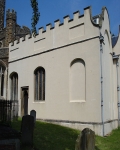de Grey Mausoleum
Archaeology »
Archaeological Monuments » de Grey Mausoleum
de Grey Mausoleum - United kingdom
de Grey Mausoleum is located in Bedfordshire, England.
de Grey Mausoleum monument was established on 1614.
Primary threats to de Grey Mausoleum :
The Mausoleum contains over twenty monuments to the de Grey family who lived in nearby Wrest Park.
Historical facts of de Grey Mausoleum :
- The de Grey Mausoleum is an architectural gem and a significant historical site located in Flitton, Bedfordshire, England. This elegant mausoleum, also known as the Flitton Mausoleum, has a rich history and holds great cultural importance. Let us explore the historical facts surrounding the de Grey Mausoleum.
- Constructed in the early 17th century, the de Grey Mausoleum was commissioned by the de Grey family, who were prominent landowners in the area. It was designed by the renowned English architect, Inigo Jones, who is considered one of the pioneers of classical architecture in England. The mausoleum stands as a fine example of Jones' work, showcasing his characteristic attention to detail and classical design principles.
- The de Grey Mausoleum was built to serve as the final resting place for the de Grey family members. It features a rectangular shape with a portico supported by four Ionic columns, creating an imposing and grand appearance. The exterior is constructed using local red brick and adorned with stone accents, adding to its aesthetic appeal.
- One of the most remarkable features of the de Grey Mausoleum is its intricate interior. The vaulted ceiling is adorned with beautiful plasterwork, displaying ornate patterns and delicate designs. The walls showcase elegant marble plaques commemorating the de Grey family members interred within the mausoleum. These plaques provide a glimpse into the family's lineage and history, offering valuable insights into the local aristocracy of the time.
- Over the years, the de Grey Mausoleum has seen several additions and renovations. In the 18th century, a dome was added to the structure, further enhancing its architectural beauty. The dome features large windows that allow natural light to filter into the mausoleum, illuminating the interior and adding to its ethereal ambiance.
- The de Grey Mausoleum has witnessed its fair share of historical events and moments. During the English Civil War in the 17th century, the mausoleum served as a temporary refuge for Parliamentary troops. It withstood the test of time and remained intact, despite the conflicts and turmoil that surrounded it.
- In the 19th century, the de Grey Mausoleum underwent restoration efforts to preserve its historical significance. The mausoleum was listed as a Grade I listed building in recognition of its architectural and historical importance. This designation ensures its protection and conservation for future generations to appreciate and enjoy.
- Today, the de Grey Mausoleum stands as a popular tourist attraction and a symbol of local heritage. Visitors are captivated by its elegant design, intricate details, and the sense of history that permeates its walls. The mausoleum is a testament to the de Grey family's legacy and the architectural prowess of Inigo Jones, serving as a tangible link to the past.
- In conclusion, the de Grey Mausoleum is a historical treasure that embodies the rich heritage of Flitton, Bedfordshire. Its architectural beauty, craftsmanship, and historical significance make it a remarkable landmark. As a resting place for the de Grey family and a testament to their prominence in the region, the mausoleum continues to inspire awe and reverence among those who visit. The de Grey Mausoleum stands as a testament to the enduring legacy of the past and serves as a reminder of the importance of preserving our architectural and historical heritage for future generations.

